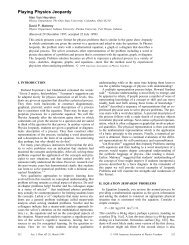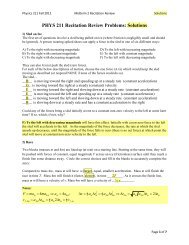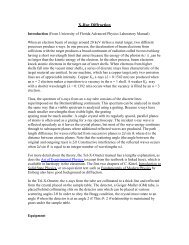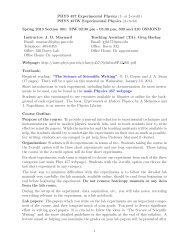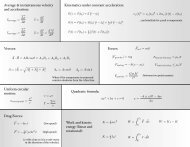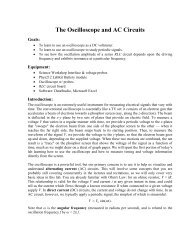optical
optical
optical
You also want an ePaper? Increase the reach of your titles
YUMPU automatically turns print PDFs into web optimized ePapers that Google loves.
Fig. 2. Blackbody spectral density versus wavelength for several temperatures.<br />
By integrating the spectral density (Eq. 1) over all wavelengths, one obtains the total radiated<br />
intensity (power per unit area) S e (T) at the temperature T :<br />
S e (T) = 2π5 k 4 B<br />
15c 2 h 3T4 = σ B T 4 (2)<br />
where σ B = 2π 5 k 4 B /15c2 h 3 = 5.67×10 −8 W/m 2 -K 4 is the Stefan-Boltzmann constant.<br />
From the plots in Fig. 2, it can be seen that ε e (λ; T) has a maximum at some λ = λ max for<br />
each T. Taking the derivative of Eq. 1 with to respect to λ and setting it equal to zero gives<br />
an equation which can be solved for λ max as a function of T :<br />
This is known as the Wien displacement law.<br />
λ max = ( 2.90 × 10 −3 m-K ) T −1 (3)<br />
Actual thermal radiation devices are not quite ideal, theoretical blackbodies. Real devices do<br />
not have perfect absorbance but reflect some fraction of any incident radiation. The deviation<br />
from perfect absorbance by a particular material is given by a function a e (λ; T) < 1; because<br />
of the balance between absorption and emission of radiation, this quantity is referred to as<br />
either absorptivity or emissivity. For real devices approximating a blackbody, the formulas<br />
for ε e (λ; T) and S e (T) must be multiplied by the absorptivity a e (λ; T) characterizing the<br />
device. In the optics lab experiment on blackbody radiation, the radiator involves a tungsten<br />
filament; the absorptivity function for tungsten is shown in Fig. 3.<br />
4




